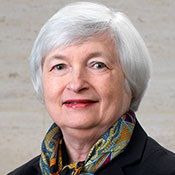The Blanchard Economic Report – 5 Questions about Fed Policy and Gold
Posted on
What do the rate you pay for your car loan, your credit card interest rate and mortgage loan all have in common? They are all based on the Federal Reserve’s benchmark interest rate.
While many investors don’t pay much attention to what goes on behind closed doors at the central bank, its policies affect markets and your pocketbook.
The Fed, currently led by Chair Janet Yellen, continues to show an extremely accommodative monetary policy stance. In plain English – it means interest rates are still really low – well below long-term historical averages.

Janet Yellen, chair of the Federal Reserve took office in February 2014. Her term is set to expire in January 2018.President Trump has said that he will replace Yellen.
That’s generally good news for borrowers, as loan rates tend to be lower. For savers and others who are looking for an income stream off of traditional types of vehicles (such as savings accounts or certificate of deposits) it’s been downright bad news since the global financial crisis hit in 2008.
A Quick History
The Fed’s benchmark rate – the federal funds rate – currently stands at a mere 0.50%-0.75%. That’s low. Looking back in 2006 – the fed funds rate stood at 5.25%. A more historically “normal” or neutral rate is in the 3.5-4.0% range.
- Why are rates so low? Since the global financial crisis and Great Recession hit in 2008, the Federal Reserve flooded the financial system with liquidity – in an effort to encourage lending and spending to get the economy moving again.
- Has it worked? The Fed has certainly come under its fair share of criticism in recent years, but there are some who say that former Fed Chair Ben Bernanke’s actions in the wake of the crisis prevented another Great Depression.
In recent years, Fed Chair Yellen has been attempting to bring interest rates higher – to a more historically normal rate. The goal is to normalize interest rates so if another recession hits, the Fed will be able to stimulate the economy with lower rates.
Various stumbling blocks from concerns over global growth, to uncertainty in the wake of Brexit, to sluggish economic growth and low inflation have all tied the Fed’s hands in recent years and interest rates remain extremely low.
- How does this impact gold? The yellow metal benefited significantly in the years following the global financial crisis from the central bank’s actions. Not only in the U.S. but the European Central Bank and the Bank of Japan initiated so-called “quantitative easing” measures, which in its simplest form has been referred to as money-printing. The Fed has dramatically expanded its balance sheet to all-time record high levels since the global financial crisis. Investors around the world bought gold as a hedge against paper money depreciation and devaluation. After all – the bigger the money supply of paper dollars, the less it is theoretically worth.
- What’s next for the Fed? This year, the Fed has broadcast its intentions to hike interest rates two or three times. For now, the June Fed meeting is the next likely time for an interest rate hike. But, there are a variety of factors that could once again derail the Fed’s best intentions including:
- Unknowns over how Trump Administration policies will impact the economy
- Still sluggish economic growth could hold the Fed back
- Pressure to push the U.S. dollar lower could become a political issue for the Fed.
- What does this mean for gold? Even if the Fed hikes rates one to three times in 2017 – it would still leave interest rates low by historical standards. Fed rate hikes may pose a modest, but minimal headwind for gold this year, considering that rates remain low compared to pre-global financial crisis levels.
Stay tuned for fresh comments from Federal Open Market Committee (FOMC) officials this week:
- Thursday: Louis Fed President Bullard (non-voting member of FOMC) speaks at Washington University at a finance forum on the U.S. economy and monetary policy.
- Thursday: Chicago Fed President Evans (voting member) speaks in Chicago on current economic conditions and monetary policy at the CFA Society of Chicago.
- Saturday: Vice Chair Fischer (voting member) speaks in England to address the Warwick Economics Summit at the University of Warwick.
Monetary policy is only one factor that affects gold prices. There are many more including stock market volatility, rising inflation, geopolitical uncertainty and overall financial conditions.
We at Blanchard and Company believe that most of our clients benefit by talking to one of our Portfolio Managers before they make any purchase. The precious metals market is complicated and in constant flux. We follow it far more closely than the average person, even diehard gold bugs. Getting a second opinion before you buy can dramatically improve your purchasing power and avoid making a bad purchase. We can also help educate you on topics such as IRA’s, inheritance, storage, diversification and more. Contact us at 1-800-880-4653.







